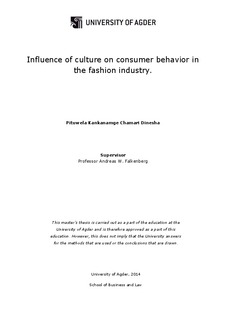| dc.description.abstract | Wearing clothes is one of the main factors that differentiate us from animals. Human beings began wearing clothes more than 170,000 years ago after the second-to-the-last-ice age. The historical invention of weaving machine changed the way fabrics were made and thus our garments; from being tailor made to being mass-produced. We may now dress differently depending on the time, the occasions, the environment, as well as based on culture.
People all over the world can make different choices based on different preferences. Consumers buy the items with which they feel familiar and comfortable. An individual’s preferences and level of comfort is derived through the inherent things that guide him or her to make decisions in a particular direction while they make decisions. The culture in which a person was raised represents a major influence in the preference for one’s clothing. In the last decade, the world business environment is experiencing drastic changes by moving the clothing industry from mass marketing into an era of mass customization.
Differentiated products aimed at specific segments have become a necessary marketing strategy in an industry characterized by fierce competition to see who can please the customers the best. Historically, most purchasing of clothes was perhaps planned as economic resources were scarce. However, it seems that we now see a growing number of customers buying clothing on impulse i.e. an unplanned purchase. This is a new challenge for the clothing industry.
What: The purpose of the current study is, to investigate impulse buying behavior of clothes by young women from Norway and Sri Lanka; two very different cultures.
Why: Most of the past research studies have focused on western countries, and very few of Asian countries. None of the research study can find regarding the Sri Lankan context. Therefore it is interesting to conduct a study focused on the Sri Lankan context.
How: Hopefully this study will be helpful for the retailers and marketing managers to understand the impulse buying behavior in the context and thereby set up adequate strategies to implement impulse purchase
Using a quantitative approach, the study was conducted with a sample of 150 undergraduates representing both countries. A self- administered questionnaire was used to test five variables influencing impulse buying behavior. The results indicated that , availability of time and in-store promotion had no any significant relationship on impulse buying while influence from reference groups, shopping emotion and availability of money for shopping trips significantly impact on impulse buying. | nb_NO |
